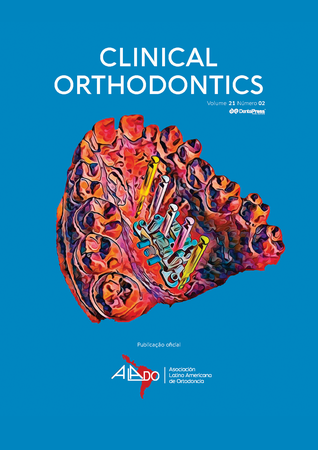Editorial Board
Autores: Marcio Rodrigues de Almeida,
messages.RevistaAutores:
LEIA MAIS
Retention, stability and relapse in Orthodontics
You may have heard the famous phrase: stability is determined when the patient stops using the retainers! Orthodontic treatment represents one of the greatest challenges for orthodontists. Therefore, many argue that retainers should be used for the rest of their lives! Yes, maintaining the...
Autores: Marcio Rodrigues de Almeida,
messages.RevistaAutores: editorial,
LEIA MAIS
An interview with Dauro Oliveira
The paths along which life takes us are funny. Before talking about Professor Dauro's magnificent academic career, I would like to comment on the paths that led me from admirer to friend. I met him during lectures promoted by the now extinct SMO (Sociedade Mineira de Ortodontia), today known as...
Autores: José Augusto Mendes Miguel, Matheus Melo Pithon, Lincoln Issamu Nojima, Juan Martin Palomo, Dauro Oliveira, Ildeu Andrade, Leena Palomo,
messages.RevistaAutores: entrevista,
LEIA MAIS
Interproximal reduction in the present (and in the past as well) - Part I
INTRODUCTION: Interproximal reduction (IPR) is a safe procedure that has been used for decades in Orthodontics. OBJECTIVE: In this first part, this article aims to describe the indications of IPR to adjust tooth-size discrepancies, and demystify their direct relationship with any specific...
Autores: Renato Parsekian Martins,
messages.RevistaAutores: Diagnosis, Orthodontic setup, Interproximal reduction,
LEIA MAIS
Class II treatment in hyperdivergent patient with maxillary intrusion, using self-ligating passive appliances with individual prescription, associated with orthodontic miniscrews
INTRODUCTION: Correction of the Class II malocclusion in growing hyperdivergent patients requires a different approach from the traditional orthodontic treatments, which do not present good results. OBJECTIVE: This article presents, by means of a case report, a suggestion of protocol to correct...
Autores: Henrique Mascarenhas Villela,
messages.RevistaAutores: Miniscrew, Mini-implants, Class II malocclusion, Hyperdivergent,
LEIA MAIS
Class II correction with aligners: how to optimize treatment with and without the use of mini-implants anchorage
INTRODUCTION: When properly diagnosed and planned, sequential distalization using Invisalign® system obtains great clinical results. However, the correction of severe Class II malocclusions often requires the use of auxiliary devices to enhance or provide adequate sagittal correction....
Autores: Guilherme Thiesen,
messages.RevistaAutores: Orthodontic appliances, Malocclusion, Angle Class II, Mini dental implant,
LEIA MAIS
Guided surgical digital planning for suture cortical perforation: Cortex Guide
INTRODUCTION: In MARPE (miniscrew-assisted rapid palatal expander) therapy, even using virtual surgery (MARPE Guide), some cases are borderline. Patients with increased interdigitation of the midpalatal suture, bone and soft tissue volume variation, presence of a palatine torus, present a strong...
Autores: Cristiane B. André,
messages.RevistaAutores: orthodontics, Palatal Expansion Technique, cone-beam computed tomography, Osteotomy,
LEIA MAIS
An extremely rare genetic variant of Pierre-Marie and Santon’s disease and orthodontic treatment options
INTRODUCTION: Pierre-Marie and Santon’s disease, also commonly referred to as cleidocranial dysplasia, is a rare autosomal dominant genetic disorder. OBJECTIVE: This manuscript describes an extremely rare variant of Pierre-Marie and Santon’s disease that has never been documented in the...
Autores: Anand Marya, Adith Venugopal, Nikhilesh Vaid,
messages.RevistaAutores: orthodontics, Cleidocranial dysplasia, Pierre-Marie and Santon’s disease, Syndrome, Genetic disorder,
LEIA MAIS
Orthognatic surgery performed after skeletal Class II correction attempt using orthodontic camouflage: case report
INTRODUCTION: The evolution of orthognatic surgery in the last few years has reduced the side effects of surgery, and increased patients and dentists satisfaction with the procedure. When properly indicated, it allows for orthodontic finalization with an aesthetically pleasing and functional...
Autores: Marco Abdo Gravina, Sergio Luiz Mota Júnior, Analina Braga APOLINÁRIO, Daniela Gomes de Rezende AZEVEDO, Lara Passos ALVIM, Fernanda Farage da Costa Felipe FERREIRA, Tariza Gallicchio MOREIRA,
messages.RevistaAutores: Malocclusion, Orthognathic surgery, Angle Class II, Retreatment,
LEIA MAIS
Workflow in orthognathic surgery virtual planning
OBJECTIVE: Technical note of a simplified workflow, in order to facilitate the clinician’s adherence to the virtual planning of orthognathic surgery, without compromising the accuracy of the technique. METHODS: For this, a literature review was carried out on the processes involved in...
Autores: Arlei Cerqueira, Weber Céo Cavalcante, Luana Santos Costa,
messages.RevistaAutores: surgery, Orthognathic surgery, computer-assisted, Workflow,
LEIA MAIS
Mouthwashes used alone before patient care: reflections and implications of what they represent
OBJECTIVE: To think on the clinical and biological meaning of mouthwashes when used alone, outside the context of oral hygiene represented by brushing with toothpastes and dental floss. SCIENTIFIC BASIS: Microbial biofilms present a protective mantle in the form of a polysaccharide gel, through...
Autores: Alberto Consolaro,
messages.RevistaAutores: Mouthwashes, Antisepsis, Antiseptics, Oral rinses, Microbial biofilms,
LEIA MAIS
Orthodontic-surgical treatment of skeletal Class II malocclusion with anterior open bite
OBJECTIVE: To report the clinical case of a patient with skeletal and dental Class II malocclusion, and anterior open bite. CASE REPORT: After diagnosis and clinical and facial assessment, an orthodontic-surgical treatment was chosen. An orthodontic appliance was installed, and the maxillary...
Autores: Matheus Melo Pithon,
messages.RevistaAutores: aesthetics, Malocclusion, Open bite,
LEIA MAIS













.png)
